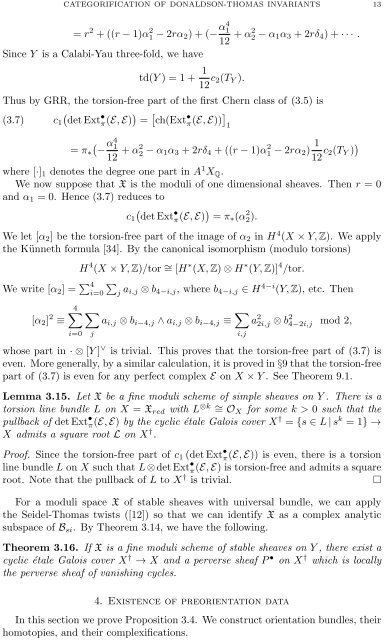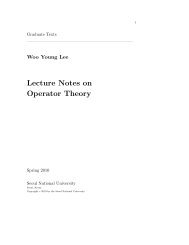Categorification of Donaldson-Thomas invariants via perverse ...
Categorification of Donaldson-Thomas invariants via perverse ...
Categorification of Donaldson-Thomas invariants via perverse ...
Create successful ePaper yourself
Turn your PDF publications into a flip-book with our unique Google optimized e-Paper software.
CATEGORIFICATION OF DONALDSON-THOMAS INVARIANTS 13= r 2 + ((r − 1)α 2 1 − 2rα 2 ) + (− α4 112 + α2 2 − α 1 α 3 + 2rδ 4 ) + · · · .Since Y is a Calabi-Yau three-fold, we havetd(Y ) = 1 + 112 c 2(T Y ).Thus by GRR, the torsion-free part <strong>of</strong> the first Chern class <strong>of</strong> (3.5) is(3.7) c 1(det Ext•π (E, E) ) = [ ch(Ext • π(E, E)) ] 1( α 4= π ∗ −112 + α2 2 − α 1 α 3 + 2rδ 4 + ((r − 1)α1 2 − 2rα 2 ) 112 c 2(T Y ) )where [·] 1 denotes the degree one part in A 1 X Q .We now suppose that X is the moduli <strong>of</strong> one dimensional sheaves. Then r = 0and α 1 = 0. Hence (3.7) reduces toc 1(det Ext•π (E, E) ) = π ∗ (α 2 2).We let [α 2 ] be the torsion-free part <strong>of</strong> the image <strong>of</strong> α 2 in H 4 (X × Y, Z). We applythe Künneth formula [34]. By the canonical isomorphism (modulo torsions)H 4 (X × Y, Z)/tor ∼ = [H ∗ (X, Z) ⊗ H ∗ (Y, Z)] 4 /tor.We write [α 2 ] = ∑ 4 ∑i=0 j a i,j ⊗ b 4−i,j , where b 4−i,j ∈ H 4−i (Y, Z), etc. Then[α 2 ] 2 ≡4∑ ∑a i,j ⊗ b i−4,j ∧ a i,j ⊗ b i−4,j ≡ ∑ a 2 2i,j ⊗ b 2 4−2i,j mod 2,ji,ji=0whose part in · ⊗ [Y ] ∨ is tri<strong>via</strong>l. This proves that the torsion-free part <strong>of</strong> (3.7) iseven. More generally, by a similar calculation, it is proved in §9 that the torsion-freepart <strong>of</strong> (3.7) is even for any perfect complex E on X × Y . See Theorem 9.1.Lemma 3.15. Let X be a fine moduli scheme <strong>of</strong> simple sheaves on Y . There is atorsion line bundle L on X = X red with L ⊗k ∼ = O X for some k > 0 such that thepullback <strong>of</strong> det Ext • π(E, E) by the cyclic étale Galois cover X † = {s ∈ L | s k = 1} →X admits a square root L on X † .Pro<strong>of</strong>. Since the torsion-free part <strong>of</strong> c 1 (det Ext • π(E, E)) is even, there is a torsionline bundle L on X such that L ⊗ det Ext • π(E, E) is torsion-free and admits a squareroot. Note that the pullback <strong>of</strong> L to X † is tri<strong>via</strong>l.□For a moduli space X <strong>of</strong> stable sheaves with universal bundle, we can applythe Seidel-<strong>Thomas</strong> twists ([12]) so that we can identify X as a complex analyticsubspace <strong>of</strong> B si . By Theorem 3.14, we have the following.Theorem 3.16. If X is a fine moduli scheme <strong>of</strong> stable sheaves on Y , there exist acyclic étale Galois cover X † → X and a <strong>perverse</strong> sheaf P • on X † which is locallythe <strong>perverse</strong> sheaf <strong>of</strong> vanishing cycles.4. Existence <strong>of</strong> preorientation dataIn this section we prove Proposition 3.4. We construct orientation bundles, theirhomotopies, and their complexifications.













